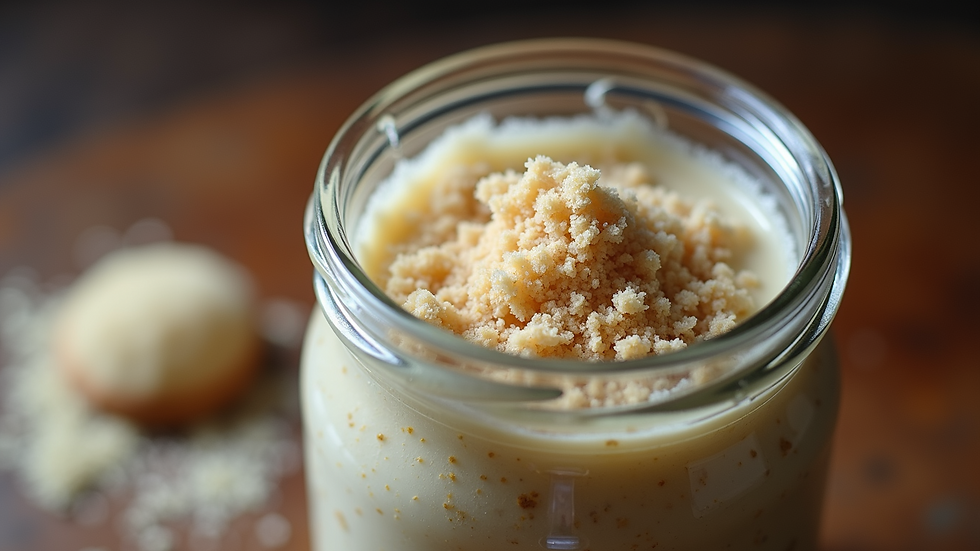The Art of Baking Naturally Leavened Bread
- STUpendous

- Jun 12
- 4 min read
Baking artisan bread is a journey that combines science, art, and a bit of magic. This skill has deep roots, with people around the world crafting unique loaves for centuries. The process of baking artisan bread, especially when using naturally leavened bread, brings out flavors and textures that are truly remarkable. In this blog post, we will explore the ins and outs of baking artisan bread, covering the methods, benefits, and tips to ensure your bread turns out perfectly every time.
What is Artisan Bread?
Artisan bread is distinct from mass-produced bread. It is typically handcrafted in small batches and usually has fewer ingredients. The primary ingredients include flour, water, salt, and natural leavening agents like sourdough starters. These elements work together to create breads with complex flavors and crusty textures.

Adding your personal touch is one of the joys of baking artisan bread. This could be anything from unique grain blends to adding ingredients like herbs or fruits. The key point is that every loaf can be personalized, showcasing the baker's creativity.
The Benefits of Baking Artisan Bread
Baking your bread comes with numerous benefits. Firstly, it allows you complete control over the ingredients. This is especially important for those who are health-conscious or have dietary restrictions. You can choose organic flours or make gluten-free options that align with your needs.
Secondly, the process is incredibly rewarding. The aroma that fills your kitchen while the bread bakes is unmatched. The result is not just a loaf but a sense of accomplishment. Studies suggest that engaging in baking can improve mental health, offering a creative outlet that reduces stress.
Lastly, fresh artisan bread tastes significantly better than store-bought options. The flavors are deeper, and the textures are more complex due to the slow fermentation process often used in artisan baking. This method develops the natural flavors present in the ingredients, enhancing the overall taste.
Understanding Leavening Agents
At the heart of baking artisan bread is the leavening agent. Naturally leavened bread is made using wild yeast and bacteria found in the environment. When you create a sourdough starter, you are capturing these microorganisms to ferment the dough. This is a slower process than using commercial yeast, yet the rewards are worth it.
Commercial yeast only ferments sugars, whereas wild yeast can metabolize various compounds in flour. This leads to an explosion of flavors and aromas that you simply can’t replicate with store-bought yeast. Understanding these differences will change the way you think of bread baking.

Essential Ingredients for Baking Artisan Bread
To bake artisan bread, you need a few key ingredients:
Flour: The type of flour you use impacts the flavor and texture. Bread flour has a higher protein content and is often preferred for its gluten-forming capabilities.
Water: This should ideally be filtered or bottled, especially if your tap water has a strong taste or excess chlorine.
Salt: Sea salt or kosher salt is recommended for better flavor and texture.
Leavening agent: This is often a sourdough starter but can also include other natural leavening methods.
Each ingredient plays a vital role in the final product. For example, the right water-to-flour ratio affects hydration levels, leading to the perfect crumb structure.
Step-by-Step Guide to Baking Artisan Bread
Here’s a simple recipe to try for your first loaf of artisan bread:
Ingredients
500g bread flour
350g water (room temperature)
10g sea salt
100g sourdough starter
Instructions
Mixing: In a large bowl, combine flour and water. Stir until there are no dry spots. Let this sit for about 30 minutes to an hour (this process is called autolyse).
Adding Ingredients: Once the dough has rested, sprinkle the salt and add the sourdough starter. Mix until combined. The dough will be sticky; this is normal.
Bulk Fermentation: Cover the bowl with a damp cloth and let it sit at room temperature for 4-12 hours, depending on the temperature. Every 30 minutes, stretch and fold the dough to develop gluten.
Shaping: Once the dough has doubled in size, turn it out onto a floured surface. Shape it using the stretch and fold method, and place it in a proofing basket lined with a floured cloth.
Final Proof: Cover the dough and let it rise for another 1-2 hours or until puffed.
Baking: Preheat your oven to 450°F (232°C) with a Dutch oven inside. Once hot, carefully place the dough in the pot, cover it, and bake for 30 minutes. Remove the lid and bake for an additional 15-20 minutes until golden brown.
Cooling: Once baked, let the bread cool completely on a wire rack before slicing.

Troubleshooting Common Issues
Baking artisan bread can sometimes result in issues. Here are a few common problems and their solutions:
Flat Bread: This could be due to under-proofing. Ensure your dough rises adequately and reaches the right volume before baking.
Dense Texture: Over-kneading can lead to a tough loaf. Mix just until incorporated and rely on the folding method to build gluten.
Burned Crust: Oven temperature can vary. Consider using an oven thermometer to ensure accurate readings. You can also adjust the baking time slightly to prevent burning.
By keeping these common issues in mind and learning from them, you can continue to improve your artisan bread-making skills.
A Lifelong Journey of Crafting Bread
Baking artisan bread is more than just a cooking technique; it is a lifelong journey filled with learning and creativity. Each loaf teaches you something new, whether it be adjusting hydration levels or experimenting with new flours.
Baking connects you to a long tradition of craftsmanship, and every bread you create can tell a story. By incorporating naturally leavened bread and honing your skills, you can elevate your baking to a new level and share that love for bread with family and friends.
As you embark on this journey, remember to have fun and enjoy the process. Happy baking!





Comments